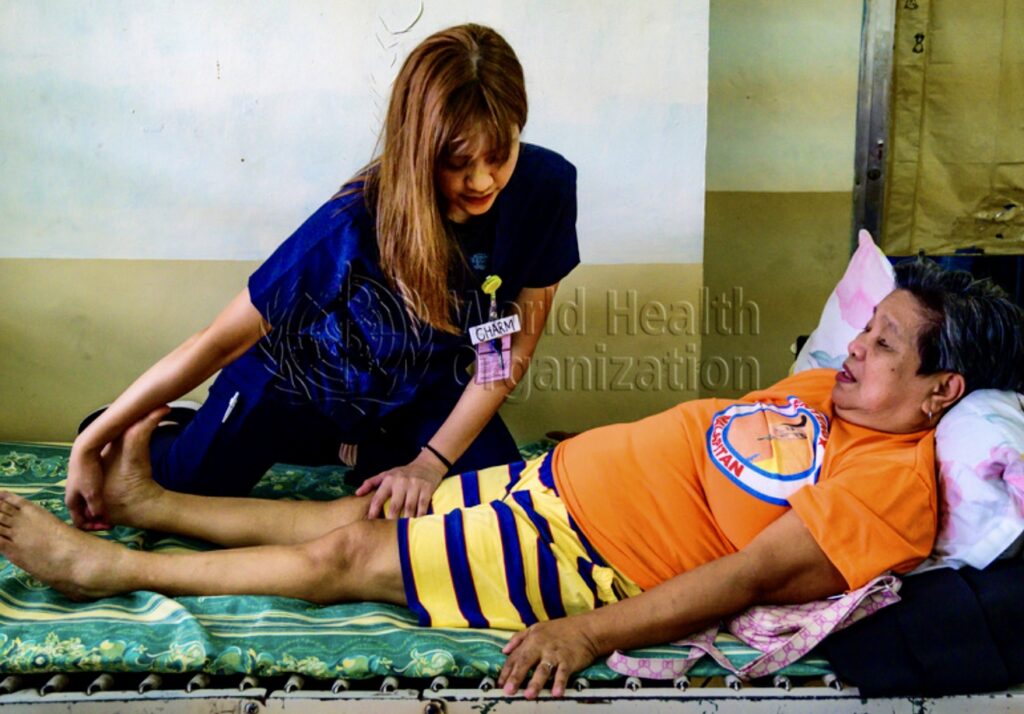NONCOMMUNICABLE DISEASES ON THE RISE
By Henrylito D. Tacio
Photos courtesy of WHO
Although his doctor told him that he was most likely to have diabetes, Jerry never changed his habits and didn’t heed the doctor’s advice of losing 20 kilograms. To think of, his only sister had died of the said disease.
“I didn’t have that sense of urgency,” he said then. But nine months later, his condition had worsened. The doctors diagnosed him with diabetes.
“I should have followed what the doctors told me,” he says now. “I really never thought it would happen to me too soon.”

Diabetes is among the noncommunicable diseases (NCDs) that kill 300,000 Filipinos each year, according to the Department of Health (DOH). NCDs are called noncommunicable because they are not passed from person to person. They are of long duration and generally slow progression.
Random genetic abnormalities, heredity, lifestyle or environment can cause noncommunicable diseases. Aside from diabetes, other examples include cancer, stroke, asthma, hypertension and osteoporosis. Autoimmune diseases, trauma, fractures, mental disorders, malnutrition, poisoning and hormonal conditions are in the category of noncommunicable diseases.
Alarmingly, NCDs are on the rise! Take the case of diabetes, once touted as a “disease of affluence.” In the Philippines, diabetes is the eighth leading cause of mortality. Studies show that every day, 500 Filipinos are added to the demographic. While there are an estimated 4 million diagnosed patients, some 4.2 million are undiagnosed.
While NCDs affect different parts of the human body in different ways, they often share common origins. And Filipinos are at high risk of coming down with one or more of these deadly diseases. An editorial, which appeared in “Manila Bulletin,” pointed out these alarming statistics:
* More than one-third of people aged 15 years and above – some 15.7 million children, women, and men – are smokers while over half of men and women aged 20 years and above are binge drinkers.
* More than one in five people have high blood pressure and only half of the population does sufficient physical activity.
* The proportion of adults who are overweight or obese has doubled in the last 20 years, and obesity in children and teens is rising at an alarming rate.
* Over 90% of Filipino adults did not meet the intake of 400 grams of fruits and vegetables per day as recommended by the World Health Organization (WHO).
* About 30% of children suffer from stunting, a condition which further predisposes them to an increased risk for obesity, diabetes and cardiovascular disease later in life.

“Once considered diseases of industrialized countries or of the affluent in developing countries, noncommunicable diseases are now recognized as global problems,” notes “Priorities in Health,” the companion volume of “Disease Control Priorities in Developing Countries.”
The rise of NCDs all over the world is an enormous challenge, according to the WHO. “For some countries, it is no exaggeration to describe the situation as an impending disaster; a disaster for health, for society, and most of all for national economies,” the Geneva-based UN health agency.
Each year, more than 36 million people die of NCDs. “Nearly 80% of NCD deaths – 29 million – occur in low- and middle-income countries,” WHO points out. “More than nine million of all deaths attributed to NCDs occur before the age of 60; 90% of these ‘premature’ deaths occurred in low- and middle-income countries.”
But it seems NCDs are not getting enough attention from the media as it should have. In the Philippines, for instance, when 21 people, mostly children, die from measles, it will immediately make headlines.
“The truth is one person dies every three minutes of NCDs. Why aren’t we complaining?” asked Dr. Teodoro Herbosa at the time when he was still DOH undersecretary. He considered NCDs as a silent epidemic.
In an article, Dr. Herbosa told the author that 63% of global deaths are caused by NCDs. About six million people die every year due to smoking and another 3.1 million die of physical inactivity, which is the fourth leading risk for global deaths. Four percent of total deaths are alcohol-related.

According to WHO, no one is spared from NCDs. “NCDs are often associated with older age groups, but evidence shows that more than 9 million of all deaths attributed to NCDs occur before the age of 60,” the UN health agency reports. “Children, adults and the elderly are all vulnerable to the risk factors that contribute to NCDs, whether from unhealthy diets, physical inactivity, exposure to tobacco smoke or the effects of the harmful use of alcohol.”
The WHO says NCDs “are driven by forces that include ageing, rapid unplanned urbanization, and the globalization of unhealthy lifestyles.” For instance, globalization of unhealthy lifestyles like unhealthy diets may show up in individuals as raised blood pressure, increased blood glucose, elevated blood lipids, overweight and obesity. These are called “intermediate risk factors” which can lead to cardiovascular disease, a NCD.
In terms of attributable deaths, the leading NCD risk factor globally is elevated blood pressure (to which 16.5% of global deaths are attributed) followed by tobacco use (9%), raised blood glucose (6%), physical inactivity (6%) and overweight and obesity (5%).
“Chronic noncommunicable diseases deliver a two-punch blow to development,” the WHO points out. “They cause billions of dollars in losses of national income, and they push millions of people below the poverty line, each and every year.”
Poverty is closely linked with NCDs. The rapid rise in NCDs is predicted to impede poverty reduction initiatives in low-income countries, particularly by forcing up household costs associated with health care. Vulnerable and socially disadvantaged people get sicker and die sooner than people of higher social positions, especially because they are at greater risk of being exposed to harmful products, such as tobacco or unhealthy food, and have limited access to health services.
“In low-resource settings, health-care costs for cardiovascular diseases, cancers, diabetes or chronic lung diseases can quickly drain household resources, driving families into poverty,” the WHO states. “The exorbitant costs of NCDs, including often lengthy and expensive treatment and loss of breadwinners, are forcing millions of people into poverty annually, stifling development.”
In many countries, “harmful drinking and unhealthy diet and lifestyles occur both in higher and lower income groups. However, high-income groups can access services and products that protect them from the greatest risks while lower-income groups can often not afford such products and services,” the WHO adds.
Dr. Herbosa outlines three measures Filipinos can do to counteract the effects of NCDs: 1) generate public interest in and awareness of healthy lifestyle choices; 2) encourage target publics to make personal commitments to healthy living; and 3) engage private and public institutions to commit to establishing environments that encourage healthy lifestyle choices.
“Political will and collective action are crucial to tackling NCDs and paving the way for a sustainable, more prosperous future for the Philippines,” the “Manila Bulletin” editorial reminds. “When people have the opportunity to live long healthy lives, they play an active role in the country’s development.”
And there is some good news, too. Filipinos can take control of their lives and need not be affected with NCDs – if they do something about it before NCDs control them. Take the case of diabetes. A 10-year study conducted at the National Heart, Lung, and Blood Institute in Bethesda, Maryland, showed the five best ways to prevent the disease. These are:
· Try to achieve your normal weight.
· Don’t smoke. People who didn’t develop diabetes were non-smokers or they had stopped smoking for at least 10 years already.
· Be physically active. People who exercised regularly were more likely to have normal blood sugars.
· Avoid or limit alcohol intake. The more a person drinks, the more they are prone to engage in other unhealthy habits like eating too much, smoking and lack of exercise.
· Choose healthy foods. Dr. Jared Reis, lead author of the study, explained that among all five factors, being overweight was linked most strongly to diabetes risk.

